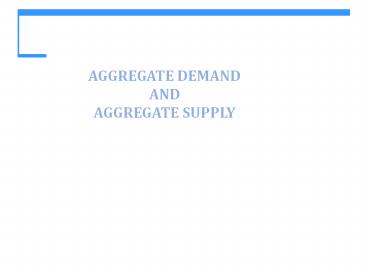AGGREGATE DEMAND AND AGGREGATE SUPPLY - PowerPoint PPT Presentation
Title:
AGGREGATE DEMAND AND AGGREGATE SUPPLY
Description:
In the short-run the aggregate price level are determined by the interaction of ... Short-run macroeconomic equilibrium occurs when the quantity of real GDP ... – PowerPoint PPT presentation
Number of Views:110
Avg rating:3.0/5.0
Title: AGGREGATE DEMAND AND AGGREGATE SUPPLY
1
AGGREGATE DEMAND ANDAGGREGATE SUPPLY
2
Production and Prices
- Applied questions.
- Why economies experience economic fluctuations?
- How do policy actions by the government and the
Federal Reserve affect output and prices? - To answer the applied questions we need to answer
first the following theoretical questions - How is GDP determined in the short-run?
- How is the price level determined in the
short-run?
3
Determination of GDP and Price level
- In the short-run the aggregate price level are
determined by the interaction of the aggregate
supply and the aggregate demand. - Aggregate supply relates aggregate production to
the price level - Aggregate demand relates aggregate expenditure to
the price level
4
Aggregate Supply
- Aggregate Supply Fundamentals
- At any given time, the quantity of capital and
the state of technology are fixed but the
quantity of labor can vary - GDP F(K,L,TFP) - Thus, short-run fluctuations in employment are an
important driving force of short-run fluctuations
in GDP. - The wage rate that makes the quantity of labor
demanded equal to the quantity supplied is the
equilibrium wage rate and at that wage the level
of employment is the natural rate of
unemployment.
5
Aggregate Supply
- Aggregate Supply Fundamentals
- Aggregate supply with perfect price flexibility
(also called by the book Long-run AS) - Aggregate supply where prices slowly adjust (the
short-run aggregate supply curve)
6
Aggregate Supply
The LAS curve is vertical because potential GDP
is independent of the price level. Along the LAS
curve all prices and wage rates vary by the same
percentage so that relative prices and the real
wage rate remain constant (NEED TO EXPLAIN WHY
THIS IS TRUE AND IT IS NOT EXPLAINED IN THE BOOK!)
7
Aggregate Supply
- The SAS curve is upward sloping because
- A rise in the price level assuming wages fixes
induces firms to hire more workers and to
increase production - Can wages continue to be fixed?
8
Aggregate Supply
- Along the SAS curve, real GDP might be above
potential GDP - or below potential GDP
- Because employment can be above or below the
regular full employment level
9
Aggregate Supply
- Changes in Aggregate Supply
- When potential GDP increases, both the LAS and
SAS curves shift rightward. - Potential GDP changes, for three reasons
- Change in the quantity of capital (physical or
human). - Advance in technology.
- And, in general, anything that effects
equilibrium employment levels.
10
Aggregate Demand
- The quantity of real GDP demanded, Y, is the
total amount of final goods and services produced
in the United States that people, businesses,
governments, and foreigners plan to buy. - This quantity is the sum of consumption
expenditures, C, investment, I, government
purchases, G, and net exports, X M. That is - Y C I G X M.
11
Aggregate Demand
- The Aggregate Demand Curve
- Aggregate demand is the relationship between the
quantity of real GDP demanded and the price
level. - The aggregate demand (AD) curve plots the
quantity of real GDP demanded against the price
level.
12
Aggregate Demand
- Buying plans depend on many factors and some of
the main ones are - The price level
- Expectations
- The world economy
13
Aggregate Demand
- The AD curve slopes downward for two reasons
- A wealth effect
- Substitution effects
14
Aggregate Demand
- Wealth effect A rise in the price level, other
things remaining the same, decreases the quantity
of real wealth (money, bonds, stocks, etc.). - To restore their real wealth, people increase
saving and decrease spending, so the quantity of
real GDP demanded decreases.
15
Aggregate Demand
- International substitution effect A rise in the
price level, other things remaining the same,
increases the price of domestic goods relative to
foreign goods, so imports increase and exports
decrease, which decreases the quantity of real
GDP demanded.
16
Macroeconomic Equilibrium
- Short-Run Macroeconomic Equilibrium
- Short-run macroeconomic equilibrium occurs when
the quantity of real GDP demanded equals the
quantity of real GDP supplied at the point of
intersection of the AD curve and the SAS curve.
17
Macroeconomic Equilibrium
- If total output and the price level are above
equilibrium GDP, firms will have to decrease
production and lower prices.
18
Macroeconomic Equilibrium
- These changes bring a movement along the SAS
curve toward equilibrium. - In short-run equilibrium, real GDP can be greater
than or less than potential GDP.
19
Macroeconomic Equilibrium
- Long-Run Macroeconomic Equilibrium
- Long-run macroeconomic equilibrium occurs when
real GDP equals potential GDPwhen the economy is
on its LAS curve.
20
Macroeconomic Equilibrium
Long-run equilibrium occurs where the AD and LAS
curves intersect and results when the money wage
has adjusted to put the SAS curve through the
long-run equilibrium point.































